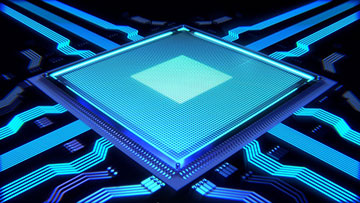
All-optical computing might one day become reality thanks to new research that sees a hydrogel acting as an intermediary between two laser beams. [Image: Pixabay]
For decades scientists have been trying to build computers that process information using light rather than electric currents. One of the biggest stumbling blocks has been finding a suitable nonlinear process to carry out the optical equivalent of a transistor’s switching. But now a U.S.–Canadian research collaboration believes it may have the answer—a specially-designed gel that allows quite weak laser beams to guide themselves and interact with other beams some distance away (PNAS, doi: 10.1073/pnas.1902872117).
Electrical versus optical
Nonlinearity is central to digital computing as it allows transistors to act as switches—to transmit an electrical current when activated by a much smaller (electrical) signal. Unlike electrons, however, photons don’t naturally interact with one another. To get around this problem in their attempt to build an all-optical computer—one which would store, transmit and process data in the form of photons—researchers have been developing materials that serve as intermediaries between laser beams.
In the latest work, scientists at Harvard University, MA, USA, and McMaster University, Ontario, Canada, fired laser beams at a water-filled polymer network known as a hydrogel that also contained light-sensitive molecules. The idea was to optically induce a chemical reaction that would expel water from the material, causing the polymer network to shrink and become more dense. This would yield a higher refractive index in the path of the beam, and a lower one outside it, creating a waveguide that would in turn concentrate the beam and boost its intensity—a positive feedback loop initiated simply by switching the beam on.
Having modeled this behavior theoretically, the researchers then observed it in practice. They found that a green laser beam with just a few milliwatts of power passing through a 4-mm thick sample of hydrogel initially spread out significantly—its diameter increasing from 20 to 120 μm. But within 50 seconds, thanks to the waveguide created, the beam’s peak intensity rose 20-fold and its diameter at the exit dropped to just 40 μm. Another 200 seconds later and its intensity went up by another factor of two while its width dropped back down to 20 μm—implying little or no divergence.
Mediating laser beam interactions
Crucially, the collaboration also found that two laser beams passing through the gel at different points on the sample affected each other’s ability to create waveguides. This was true when the beams were separated by just 25 μm—their peak intensities rising by no more than a factor of five. But it was also the case when they were well out of direct contact—even when 200 μm apart they roughly halved their maximum possible intensity. That, say the researchers, comes about because while each beam increases the density of polymer in its path it simultaneously reduces that density further away (by pushing the water outwards).
That ability of the beams to interact, according to McMaster University group member Kalaichelvi Saravanamuttu, could lead to a new form of computing that doesn’t involve hard-wired circuits. “The hydrogel plays a critical role in mediating these interactions, which is captivating at the fundamental level,” she says. “We can also imagine, in the long term, designing computing operations using this intelligent responsiveness."
Suitable for computing?
In their paper, the researchers point out that their 50-to-100-second switching speeds bear no comparison with those of optoelectronic switches, which operate on nanosecond timescales. But they say that their technology nevertheless has several advantages compared to some conventional materials used in nonlinear optics, including it being repeatable, requiring little beam power and enabling quite long-distance interactions. Their system, they write, “provides proof of concept and lays the foundation for rational design of other classes of faster-responding photochromic hydrogels”.
But not everyone is convinced that the technology is suited to computing. Rodney Tucker, an electrical engineer at the University of Melbourne in Australia argues that the important metric is not optical power but energy per information bit. He says that with timescales on the order of seconds, the technique requires millijoule energies, which, he maintains, compares unfavorably with the best optoelectronic and electronic signal processing devices—operating at the picojoule- and femtojoule-level, respectively. “The technique presented here needs to improve by 12 orders of magnitude to become competitive,” he says.

